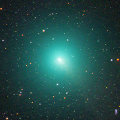
|
It approached to the earth down to 0.12 A.U. and brightened up to 4.6 mag in October (Oct. 18, Juan Jose Gonzalez). It was very large, double of the full moon, and very bright, visible with naked eyes. Now it is fading, but still bright as 9.5 mag (Jan. 15, Juan Jose Gonzalez). After this, it keeps observable for a long time until June when it fades down to 17 mag.
Date(TT) R.A. (2000) Decl. Delta r Elong. m1 Best Time(A, h)
Jan. 22 7 5.54 -11 38.0 0.637 1.546 144 10.5 22:59 (180, 66)
Jan. 29 7 4.27 -9 32.2 0.708 1.608 142 11.1 22:30 (180, 64)
|
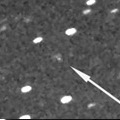
|
Now it is 12.9 mag (Dec. 27, Ken-ichi Kadota). Bright, but it locates extremely low. It will be fading after this. The condition in this apparition is bad. It will be getting higher gradually after February in the Southern Hemisphere, however, it keeps extremely low until May in the Northern Hemisphere.
Date(TT) R.A. (2000) Decl. Delta r Elong. m1 Best Time(A, h)
Jan. 22 18 10.60 -24 2.5 2.297 1.513 29 12.3 3:28 (295, 6)
Jan. 29 18 34.45 -24 23.1 2.280 1.520 30 12.3 3:38 (294, 9)
|
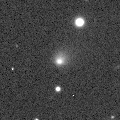
|
Already very bright, much brighter than expected, as 10.5 mag (Jan. 3, Alexandre Amorim). Not observable now. It is expected to keep so bright as 6-8 mag for a long time from 2011 to 2012, and to be observable in good condition in the Northern Hemisphere. It will appear in the morning sky in late March in the Southern Hemisphere, or in late April in the Northern Hemisphere.
Date(TT) R.A. (2000) Decl. Delta r Elong. m1 Best Time(A, h)
Jan. 22 22 6.88 -24 41.9 5.156 4.296 26 13.0 20:53 ( 63, 4)
Jan. 29 22 10.19 -23 41.7 5.136 4.231 20 12.9 20:46 ( 61, 0)
|

|
Big asteroid discovered in 1906. It suddenly showed the cometary activity on Dec. 11, probably due to an impact of a small object. It was very bright as 11.5 mag visually (Dec. 17, Juan Jose Gonzalez). It has a dust coma still on Jan. 9 (Joseph Brimacombe).
Date(TT) R.A. (2000) Decl. Delta r Elong. m1 Best Time(A, h)
Jan. 22 9 48.49 33 13.6 2.125 3.046 155 13.5 1:46 (180, 22)
Jan. 29 9 42.84 34 7.9 2.094 3.036 159 13.4 1:13 (180, 21)
|

|
Now it is 13.8 mag (Dec. 18, D. Chestnov and A. Novichonok).
Date(TT) R.A. (2000) Decl. Delta r Elong. m1 Best Time(A, h)
Jan. 22 11 15.05 -1 3.5 5.554 6.246 131 13.7 3:12 (180, 56)
Jan. 29 11 13.30 -1 2.0 5.474 6.247 138 13.7 2:43 (180, 56)
|
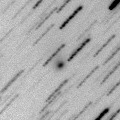
|
Now it is 12.9 mag, much brighter than originally expected and visible visually (Dec. 4, Seiichi Yoshida). In the Southern Hemisphere, it will be unobservable until spring. In the Northern Hemisphere, it will be getting lower after this. The altitude will be lower than 10 degree from February to April.
Date(TT) R.A. (2000) Decl. Delta r Elong. m1 Best Time(A, h)
Jan. 22 21 39.00 30 40.0 2.964 2.522 54 14.1 20:53 (107,-32)
Jan. 29 21 50.82 28 44.9 3.045 2.521 49 14.1 20:46 (104,-33)
|
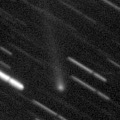
|
Now it is 13.7 mag and visible visually (Jan. 2, Carlos Labordena). It has a long tail by CCD observations. It keeps observable at 14-15 mag in good condition until spring.
Date(TT) R.A. (2000) Decl. Delta r Elong. m1 Best Time(A, h)
Jan. 22 5 12.13 -12 25.3 2.272 2.946 124 14.5 21:05 (180, 68)
Jan. 29 5 1.12 -13 36.5 2.367 2.943 116 14.6 20:46 (167, 68)
|
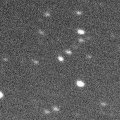
|
Now it is 14.7 mag (Dec. 27, D. Chestnov and A. Novichonok). It keeps bright as 14-15 mag for a long time after this until 2013. It is not observable in the Northern Hemisphere, but it is observable in good condition in the Southern Hemisphere.
Date(TT) R.A. (2000) Decl. Delta r Elong. m1 Best Time(A, h)
Jan. 22 16 11.17 -62 20.1 6.451 6.006 59 14.8 3:28 (325, 40)
Jan. 29 16 17.02 -63 36.9 6.359 5.985 63 14.8 3:38 (327, 43)
|
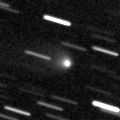
|
It is already bright as 14.5 mag and visible visually (Sept. 30, Alan Hale). Now it is unobservable. But it will appear in the morning sky in late February in the Northern Hemisphere, or in late March in the Southern Hemisphere. It will be observable at 13-14 mag for a long time from 2011 to 2012.
Date(TT) R.A. (2000) Decl. Delta r Elong. m1 Best Time(A, h)
Jan. 22 20 18.85 -7 14.7 7.095 6.139 12 15.2 20:53 ( 58,-27)
Jan. 29 20 20.75 -7 9.0 7.069 6.111 12 15.1 3:38 (296,-22)
|

|
A small outburst occured and it brightened by 2 mag, up to 16.1 mag, on 2010 Aug. 31 (Bernhard Haeusler). Now it is 15.2 mag (Dec. 22, Ken-ichi Kadota). It will brighten up to 11.5 mag in autumn. In the Northern Hemisphere, it keeps observable for a long time until 2012 spring. In the Southern Hemisphere, it is not observable until November.
Date(TT) R.A. (2000) Decl. Delta r Elong. m1 Best Time(A, h)
Jan. 22 17 4.48 28 39.3 3.491 3.232 66 15.3 3:28 (243,-11)
Jan. 29 17 12.50 30 48.4 3.364 3.174 70 15.1 3:38 (237, -7)
|
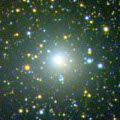
|
It reached up to 7.7 mag in 2009 summer (2009 Aug. 13, Chris Wyatt). It is fading now. It will never be observable again in the Northern Hemisphere. It becomes low also in the Southern Hemisphere. Therefore, no observations have been reported since October. But it will be getting higher after January. In the Southern Hemisphere, it keeps observable in good condition until 2011 autumn when it becomes fainter than 18 mag.
Date(TT) R.A. (2000) Decl. Delta r Elong. m1 Best Time(A, h)
Jan. 22 18 9.26 -51 7.8 6.689 5.967 39 15.2 3:28 (318, 21)
Jan. 29 18 12.93 -51 43.7 6.674 6.015 44 15.3 3:38 (316, 26)
|
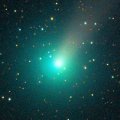
|
It brightened up to 7.9 mag in April and May (May 5, Juan Jose Gonzalez). Now it is fading. The central part is so faint as 16-17 mag. However, extremely faint large coma extends, and the total brightness is still bright as 14.3 mag (Dec. 27, D. Chestnov and A. Novichonok). It keeps observable for a long time until when it fades out in the Northern Hemisphere. It is not observable in the Southern Hemisphere.
Date(TT) R.A. (2000) Decl. Delta r Elong. m1 Best Time(A, h)
Jan. 22 4 13.99 34 23.0 3.007 3.665 125 15.2 20:53 (170, 20)
Jan. 29 4 9.93 32 45.4 3.176 3.734 117 15.5 20:46 (164, 20)
|
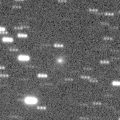
|
Now it is 15.3 mag (Dec. 27, D. Chestnov and A. Novichonok), much brighter than originally expected. It keeps 16 mag until 2011 spring. It keeps observable in good condition in the Southern Hemisphere. But in the Northern Hemisphere, it locates very low in 2011 spring only.
Date(TT) R.A. (2000) Decl. Delta r Elong. m1 Best Time(A, h)
Jan. 22 7 10.77 -65 37.9 2.712 2.944 93 15.5 23:02 ( 0, 60)
Jan. 29 6 43.96 -62 38.9 2.696 2.963 95 15.6 22:08 ( 0, 63)
|
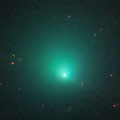
|
It has kept bright as 8.5 mag since July until September. Now it is fading, but it is still bright as 13.2 mag (Dec. 27, D. Chestnov and A. Novichonok). It may be visible visually in January.
Date(TT) R.A. (2000) Decl. Delta r Elong. m1 Best Time(A, h)
Jan. 22 1 56.99 -0 30.9 2.225 2.364 85 15.7 20:53 (119, 35)
Jan. 29 2 5.46 0 55.2 2.353 2.407 81 15.9 20:46 (118, 32)
|
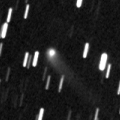
|
Now it is 15.2 mag (Nov. 27, A. Novichonok and D. Chestnov). It will be fading very slowly after this. In the Northern Hemisphere, it temporarily becomes low in January, but it keeps observable for a long time until 2012 spring when it fades down to 17-18 mag. It will not be observable in the Southern Hemisphere.
Date(TT) R.A. (2000) Decl. Delta r Elong. m1 Best Time(A, h)
Jan. 22 20 9.78 32 54.2 5.134 4.605 52 15.7 3:28 (258,-49)
Jan. 29 20 20.18 33 20.7 5.161 4.617 51 15.7 3:38 (255,-43)
|
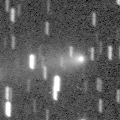
|
It reached up to 14.0 mag and became visible visually in December (Dec. 17, Juan Jose Gonzalez). It keeps locating high in the Northern Hemisphere after this. But it will be fading. It has already faded down to 16.0 mag (Jan. 23, Toshiyuki Takahashi). It will be fainter than 18 mag in April. It locates low in the Southern Hemisphere.
Date(TT) R.A. (2000) Decl. Delta r Elong. m1 Best Time(A, h)
Jan. 22 6 12.09 43 25.0 1.412 2.290 145 15.7 22:06 (180, 12)
Jan. 29 6 8.64 43 56.5 1.478 2.310 138 15.9 21:35 (180, 11)
|
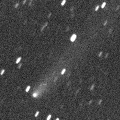
|
Now it is 16.5 mag (Jan. 6, Ken-ichi Kadota). It has a long tail by CCD observations. It keeps observable after this while fading gradually.
Date(TT) R.A. (2000) Decl. Delta r Elong. m1 Best Time(A, h)
Jan. 22 13 18.28 -26 4.7 2.192 2.453 93 15.8 3:28 (256, 65)
Jan. 29 13 20.96 -26 50.7 2.146 2.501 99 15.9 3:38 (247, 73)
|
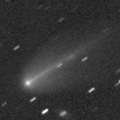
|
Bright new comet discovered visually by Kaoru Ikeya and Shigeki Murakami. It was so bright as 7.6 mag at that time (Nov. 4, Juan Jose Gonzalez). Now it is 14.8 mag (Jan. 7, Ken-ichi Kadota). Its envelope similar to 17P/Holmes is getting diffuse rapidly. The central nucleus has faded down to 17.9 mag (Jan. 14, Leonid Elenin). In the Northern Hemisphere, it keeps observable for a long time after this in the morning low sky. It locates very low in the Southern Hemisphere, but it will be getting higher gradually.
Date(TT) R.A. (2000) Decl. Delta r Elong. m1 Best Time(A, h)
Jan. 22 15 44.69 -23 42.4 2.073 1.834 62 16.5 3:28 (277, 35)
Jan. 29 15 59.29 -24 58.3 2.039 1.866 65 17.0 3:38 (275, 40)
|
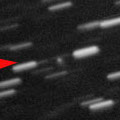
|
Now it is 15.7 mag (Jan. 23, Toru Yusa). In the Northern Hemisphere, it keeps observable in good condition until 2011 spring when it brightens up to 16 mag. In the Southern Hemisphere, it keeps locating low.
Date(TT) R.A. (2000) Decl. Delta r Elong. m1 Best Time(A, h)
Jan. 22 4 45.50 38 37.4 1.706 2.469 131 16.5 20:53 (177, 16)
Jan. 29 4 44.31 38 33.2 1.747 2.444 124 16.5 20:46 (173, 16)
|

|
It had been bright as 13-14 mag for a long time from 2007 to 2009. Now it is fading, but it is 15.3 mag still now (Dec. 10, D. Chestnov and A. Novichonok), much brighter than predicted. It keeps observable at 16 mag in good condition until spring.
Date(TT) R.A. (2000) Decl. Delta r Elong. m1 Best Time(A, h)
Jan. 22 11 46.51 39 26.3 8.733 9.405 130 16.7 3:28 (183, 16)
Jan. 29 11 42.56 39 59.8 8.709 9.441 135 16.7 3:12 (180, 15)
|

|
It was observed only during 3 days in 2009 May, then it has been lost. The ephemeris says that it passes the perihelion in 2011 January and it will be observable at 17 mag. But actually, it will not be found.
Date(TT) R.A. (2000) Decl. Delta r Elong. m1 Best Time(A, h)
Jan. 22 6 45.17 -18 10.0 3.134 3.903 136 16.9 22:38 (180, 73)
Jan. 29 6 30.30 -17 26.7 3.182 3.905 131 16.9 21:55 (180, 72)
|

|
Now it is 16.4 mag (Jan. 13, Toru Yusa). It is observable in good condition in the Northern Hemisphere. It must have been bright as 16 mag since September, but it was not discovered. It will be fading after this, and will be fainter than 18 mag in February. It locates low in the Southern Hemisphere.
Date(TT) R.A. (2000) Decl. Delta r Elong. m1 Best Time(A, h)
Jan. 22 5 8.60 42 28.7 1.209 2.027 134 17.0 21:03 (180, 13)
Jan. 29 5 13.96 41 38.6 1.290 2.063 129 17.2 20:46 (179, 13)
|

|
Asteroid discovered in 2002 was revealed to be a comet. Now it is 16.5 mag (Jan. 23, Toru Yusa). It will be fading after this, and will be fainter than 18 mag in February. It is observable in good condition in the Northern Hemisphere. It is not observable in the Southern Hemisphere.
Date(TT) R.A. (2000) Decl. Delta r Elong. m1 Best Time(A, h)
Jan. 22 6 39.98 53 59.8 0.597 1.498 141 17.1 22:35 (180, 1)
Jan. 29 6 47.37 53 57.5 0.628 1.510 137 17.3 22:15 (180, 1)
|
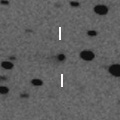
|
Now it is 17.5 mag (Dec. 9, Catalina Sky Survey). It keeps 17 mag for a long time from 2009 to 2012. It is observable in good condition in the Northern Hemisphere. It locates somewhat low in the Southern Hemisphere.
Date(TT) R.A. (2000) Decl. Delta r Elong. m1 Best Time(A, h)
Jan. 22 0 51.10 15 0.1 8.236 8.061 76 17.1 20:53 (119, 13)
Jan. 29 0 50.55 14 55.1 8.354 8.056 69 17.2 20:46 (115, 9)
|
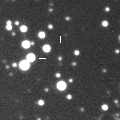
|
Now it is 16.9 mag (Nov. 28, A. Novichonok and D. Chestnov). It is expected to be 15 mag and will be observable in good condition in 2013. It is observable in good condition in the Northern Hemisphere, but not observable in the Southern Hemisphere now.
Date(TT) R.A. (2000) Decl. Delta r Elong. m1 Best Time(A, h)
Jan. 22 1 33.44 56 28.7 8.039 8.282 100 17.2 20:53 (154,-11)
Jan. 29 1 31.71 55 54.6 8.101 8.251 95 17.2 20:46 (151,-13)
|

|
Large Centaur-type asteroid. Now it is 17.0 mag (Jan. 7, Tzec Maun Observatory). It keeps observable at 17-18 mag for a long time until 2013.
Date(TT) R.A. (2000) Decl. Delta r Elong. m1 Best Time(A, h)
Jan. 22 7 45.02 -15 33.6 5.668 6.489 143 17.3 23:38 (180, 71)
Jan. 29 7 39.85 -14 41.1 5.669 6.488 143 17.3 23:06 (180, 70)
|
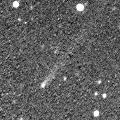
|
Now it is 17.2 mag (Dec. 27, Charles Bell). It tends to be brightest after the perihelion passage. At the discovery in 1999, it became brightest one year after the perihelion passage. At this time, it became brightest three months after the perihelion passage, then it is fading. It keeps observable in good condition at 18 mag until may.
Date(TT) R.A. (2000) Decl. Delta r Elong. m1 Best Time(A, h)
Jan. 22 10 30.80 6 49.0 2.812 3.658 144 17.3 2:28 (180, 48)
Jan. 29 10 27.60 7 1.4 2.773 3.675 152 17.3 1:57 (180, 48)
|

|
Now it is 17.9 mag (Jan. 17, Ken-ichi Kadota). It keeps 15 mag from 2011 summer to 2012 summer. But it is not observable around the perihelion. It is observable in good condition in the Northern Hemisphere in 2011, and in the Southern Hemisphere in 2012.
Date(TT) R.A. (2000) Decl. Delta r Elong. m1 Best Time(A, h)
Jan. 22 13 31.50 16 37.0 3.785 4.157 105 17.6 3:28 (214, 31)
Jan. 29 13 34.88 17 15.4 3.641 4.101 111 17.4 3:38 (205, 34)
|
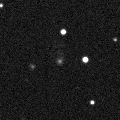
|
Now it is 17.4 mag (Jan. 5, Tzec Maun Observatory). It is fading slowly. In the Northern Hemisphere, it keeps observable in good condition until 2011 summer. It is not observable in the Southern Hemisphere.
Date(TT) R.A. (2000) Decl. Delta r Elong. m1 Best Time(A, h)
Jan. 22 17 28.17 43 3.6 5.470 5.278 73 17.5 3:28 (232,-23)
Jan. 29 17 31.74 43 9.7 5.459 5.299 75 17.5 3:38 (229,-17)
|
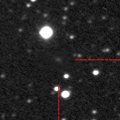
|
Now it is 18.1 mag (Dec. 13, Tzec Maun Observatory). It was observed at 18 mag in winter between 2009 and 2010. It will be observable again at 18 mag in good condition from winter to spring in 2011.
Date(TT) R.A. (2000) Decl. Delta r Elong. m1 Best Time(A, h)
Jan. 22 10 59.39 10 21.1 2.650 3.456 139 17.9 2:57 (180, 45)
Jan. 29 10 57.31 10 45.8 2.592 3.460 146 17.9 2:27 (180, 44)
|
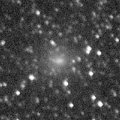
|
It was predicted so faint as 19 mag. But actually it is observed much brighter than expected, 16.6 mag on Dec. 7 (Catalina Sky Survey), and 15.7 mag on Dec. 31 (Francois Kugel). Maybe it is in outburst.
Date(TT) R.A. (2000) Decl. Delta r Elong. m1 Best Time(A, h)
Jan. 22 3 55.11 21 56.1 3.218 3.805 119 19.3 20:53 (163, 31)
Jan. 29 3 54.85 21 56.0 3.345 3.833 112 19.5 20:46 (157, 30)
|
|
![]()
 P/2010 WK ( LINEAR )
P/2010 WK ( LINEAR ) 247P/2010 V3 ( LINEAR )
247P/2010 V3 ( LINEAR ) C/2008 S3 ( Boattini )
C/2008 S3 ( Boattini ) C/2010 S1 ( LINEAR )
C/2010 S1 ( LINEAR ) 2008 YB3
2008 YB3 203P/2008 R4 ( Korlevic )
203P/2008 R4 ( Korlevic ) C/2011 A3 ( Gibbs )
C/2011 A3 ( Gibbs ) C/2007 VO53 ( Spacewatch )
C/2007 VO53 ( Spacewatch ) 31P/Schwassmann-Wachmann 2
31P/Schwassmann-Wachmann 2 88P/Howell
88P/Howell![]()

























